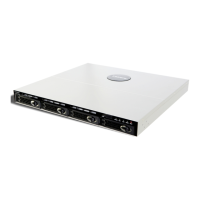160
Chapter 10: Troubleshooting
Repairing a Degraded Array
Network Storage System (NSS) Administrator Guide
Chapter
10
Repairing a Degraded Array
If a RAID level 1, 5, or 10 is in a degraded state (that is, a redundant disk drive has failed), you can
replace the failed disk drive(s). (You might be able to use some of the data on a JBOD if there are
volumes that do not span across the failed disk. Otherwise, you must rebuild the JBOD after you
replace the disk.) If an array with no redundancy has a failed disk drive, you will need to delete the
array, replace the disk drive, and then recreate the array.
NOTE: When adding disks to an array, we recommend you use the same model of disk with
the same capacity. The new disk must have at least the same capacity of the smallest
disk currently in the array. With the exception of a JBOD, RAIDs are configured to
use the maximum of the smallest disk capacity in the array for each additional disk
in the array. For example, if you install two, 250 GB disks and one 500 GB disk, the
total capacity is 750 GB.
To add a disk to a degraded array:
1. If you are replacing a disk, remove the failed drive from the NSS and install the replacement
disk.
2. From the Manager Menu, click Storage RAID.
The RAID page appears.
3. In the RAID Arrays table, click Edit for the applicable RAID array.

